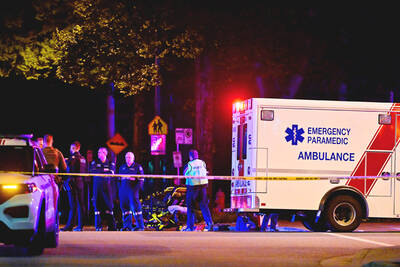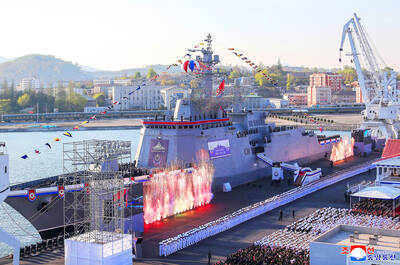A gunman killed a Colombian journalist who had received threats and reported on politicians linked to paramilitary death squads, police and the victim’s family said on Saturday.
Clodomiro Castilla, an editor of El Pulso magazine and a reporter for local radio, was shot to death on Friday night as he read a book on the terrace of his home in the city of Monteria in the north of the Andean country.
Colombia’s decades-long internal war has eased after President Alvaro Uribe sent troops to take back areas under control of rebels and paramilitaries. But armed groups and cocaine traffickers still occasionally target journalists.
“When the journalist was sitting reading a book on his terrace, he was approached by a gunman, who shot him several times and fled on a motorcycle,” said Colonel Pedro Angelo Franco, a state police commander.
The journalist’s family said he had received death threats but declined a government offer of protection.
Castilla, 49, was killed in the state of Cordoba where in the 1980s paramilitary squads were formed by landowners, ranchers and drug traffickers to defend themselves against leftist rebels fighting the state.
Several lawmakers and mayors from the region have been jailed for making deals with the outlawed militias to guarantee their election.
Ex-paramilitary commanders demobilized their fighters after reaching a peace deal with Uribe’s government. But human rights groups say remnants of the paramilitary gangs are still active and running drugs.
Colombia was once considered one of the most dangerous countries in the world for journalists to work. More than 100 reporters were killed during the 1980s and 1990s by cocaine traffickers, rebels and paramilitaries.
In other news, FARC guerrillas kidnapped five local oil contractors near a US-operated oilfield, whisking them into a mountainous area close to Venezuela with troops in pursuit, officials said on Saturday.
The captive men were working for oil service companies Tuboscope and Tecnioriente, subcontracted by the local unit of US company Occidental Petroleum, near the Caricare oilfield in the state of Arauca, a local army commander said.
A sixth worker managed to flee into bushes when rebels crashed their vehicle as army helicopters closed in on them.
Violence and kidnappings in the country’s long war have eased under Uribe, who sent troops to retake areas under rebel control. But the kidnappings underscored the threat guerrillas still present in the country.
“They kidnapped six workers from Tuboscope and Tecnioriente,” army commander General Rafael Neira told local radio. “They took them to a rural area ... the army reacted and rescued one of the workers.”
Arauca state Governor Luis Ataya said he believed the men were taken for extortion and blamed the Revolutionary Armed Forces of Colombia (FARC).
Once a powerful rebel force, the FARC has been battered to its weakest in decades. Foreign investment, especially in oil and mining, is booming as companies are drawn to Colombia.
Weakened by the loss of top commanders and desertions, the FARC has turned to hit-and-run tactics, ambushes and homemade landmines to harass troops.
But they can still carry out high-profile attacks.
In December, a guerrilla commando unit snatched the Caqueta state governor from his home, speeding him into nearby jungles where they slit his throat and dumped his body.
The oil worker kidnapping came just days before the FARC planned to free two soldiers, one of them held for nearly 12 years in secret camps in the jungle.

Archeologists in Peru on Thursday said they found the 5,000-year-old remains of a noblewoman at the sacred city of Caral, revealing the important role played by women in the oldest center of civilization in the Americas. “What has been discovered corresponds to a woman who apparently had elevated status, an elite woman,” archeologist David Palomino said. The mummy was found in Aspero, a sacred site within the city of Caral that was a garbage dump for more than 30 years until becoming an archeological site in the 1990s. Palomino said the carefully preserved remains, dating to 3,000BC, contained skin, part of the

TRUMP EFFECT: The win capped one of the most dramatic turnarounds in Canadian political history after the Conservatives had led the Liberals by more than 20 points Canadian Prime Minister Mark Carney yesterday pledged to win US President Donald Trump’s trade war after winning Canada’s election and leading his Liberal Party to another term in power. Following a campaign dominated by Trump’s tariffs and annexation threats, Carney promised to chart “a new path forward” in a world “fundamentally changed” by a US that is newly hostile to free trade. “We are over the shock of the American betrayal, but we should never forget the lessons,” said Carney, who led the central banks of Canada and the UK before entering politics earlier this year. “We will win this trade war and

‘BODIES EVERYWHERE’: The incident occurred at a Filipino festival celebrating an anti-colonial leader, with the driver described as a ‘lone suspect’ known to police Canadian police arrested a man on Saturday after a car plowed into a street party in the western Canadian city of Vancouver, killing a number of people. Authorities said the incident happened shortly after 8pm in Vancouver’s Sunset on Fraser neighborhood as members of the Filipino community gathered to celebrate Lapu Lapu Day. The festival, which commemorates a Filipino anti-colonial leader from the 16th century, falls this year on the weekend before Canada’s election. A 30-year-old local man was arrested at the scene, Vancouver police wrote on X. The driver was a “lone suspect” known to police, a police spokesperson told journalists at the

North Korean leader Kim Jong-un has unveiled a new naval destroyer, claiming it as a significant advancement toward his goal of expanding the operational range and preemptive strike capabilities of his nuclear-armed military, state media said yesterday. North Korea’s state-run Korean Central News Agency (KCNA) said Kim attended the launching ceremony for the 5,000-tonne warship on Friday at the western port of Nampo. Kim framed the arms buildup as a response to perceived threats from the US and its allies in Asia, who have been expanding joint military exercises amid rising tensions over the North’s nuclear program. He added that the acquisition